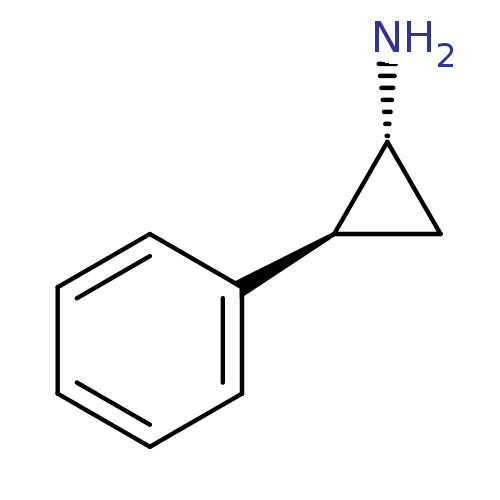BDBM50240772 (1R,2S)-(-)-2-phenylcyclopropylamine::(1R,2S)-2-phenylcyclopropanamine::(tranylcypromine)2-Phenyl-cyclopropylamine::2-Phenyl-cyclopropylamine::CHEMBL1179::Parnate::TRANYLCYPROMINE::TRANYLCYPROMINE HYDROCHLORIDE::US10836743, Compound TCP::US8993808, Tranylcypromine::US9180183, Tranylcypromine::cid_2723716::rel-Tranylcypromine
SMILES N[C@@H]1C[C@H]1c1ccccc1
InChI Key InChIKey=AELCINSCMGFISI-DTWKUNHWSA-N
Activity Spreadsheet -- Enzyme Inhibition Constant Data from BindingDB
 Found 3 hits for monomerid = 50240772
Found 3 hits for monomerid = 50240772
TargetLysine-specific histone demethylase 2(Homo sapiens (Human))
Zhengzhou University
Curated by ChEMBL
Zhengzhou University
Curated by ChEMBL
Affinity DataIC50: 3.49E+4nMAssay Description:Inhibition of recombinant LSD2 (22 to 822 aa) (unknown origin) expressed in Escherichia coli BL21(DE) by fluorescence assayMore data for this Ligand-Target Pair
TargetLysine-specific histone demethylase 1A(Homo sapiens (Human))
Zhengzhou University
Curated by ChEMBL
Zhengzhou University
Curated by ChEMBL
Affinity DataKd: 4.63E+4nMAssay Description:Binding affinity to human recombinant LSD1 (157 to 852 aa) expressed in Escherichia coli BL21(DE) by microscale thermophoresis assayMore data for this Ligand-Target Pair
TargetLysine-specific histone demethylase 1A(Homo sapiens (Human))
Zhengzhou University
Curated by ChEMBL
Zhengzhou University
Curated by ChEMBL
Affinity DataIC50: 2.78E+4nMAssay Description:Inhibition of human recombinant LSD1 (157 to 852 aa) expressed in Escherichia coli BL21(DE) using H3K4me2 as substrate by fluorescence assayMore data for this Ligand-Target Pair
